Gamut Mapping
Michael Herf

Pete Shirley should be given most of the credit for getting me excited about
computer graphics. Back in 1992, I had the chance to work with him at Indiana
University, and I got to work on the problem of mapping arbitrary-gamut images to
fixed-gamut CRT's.
In case that didn't make sense, the idea is that real images have a large
dynamic range -- they can be very bright and still have lots of detail
at very low levels. Computer monitors have a very limited range of intensities --
they're not nearly as bright as the sun, for instance. This is a problem, since
if you have an image with a large gamut and you're not smart about it,
you either get a very dark images with a few bright spots, or you get large
areas that are washed out to white.
I think that I actually came upon the specific solution in our paper,
though my implementation was pretty bogus (I had no idea how to actually
write a wide filter), and so I think Ken Chiu actually made the thing work.
(Later in life now, I'm happy to have written some of the fastest blur effects in
the industry, but so it goes.)
Working with Pete is like working with a Zen master -- he probably knows everything you're
going to do before you do it, so he was probably guiding us all using some invisible
force. I think he learned to focus on having fewer authors later,
since most of those guys got Ph.D.'s. Anyway, he wrote the paper, and there was some really
cool empirical work (with hardware?!) that went on after I left at the end
of the summer.
Anyway, some more perspective on the problem leads me to believe that we
basically rediscovered audio compression for graphics. If you don't know what
that means, look through a
pro audio catalog.
Here's a link to the paper in PDF, and a citation:
Spatially Nonuniform Scaling Functions for High Contrast Images, by
Chiu, Herf, Shirley, Swamy, Wang, Zimmerman.
Proceedings of Graphics Interface '93.
[pdf]
